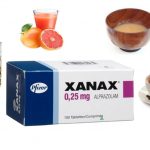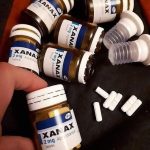What Happens To You After Taking Xanax For A Week Then Stopping?

What is Xanax?
Xanax is a brand of alprazolam, a powerful benzodiazepine that is used to treat anxiety and panic disorders by decreasing abnormal excitement in the brain. The medication comes in the form of a tablet that quickly dissolves in the mouth, and extended-release tablet, or a concentrated oral solution.
Benzodiazepines can have therapeutic anti-anxiety, anti-convulsant, muscle relaxing, and sedative effects. Xanax works by increasing the effects of a brain chemical called gamma-aminobutyric acid (GABA), which promotes calmness and produces a relaxed feeling. The drug decreases the level of excitement in the brain to treat anxiety and panic disorders.
Alprazolam is among the most prescribed benzodiazepine drugs in the U.S. and is among the benzodiazepines most often found in the illegal market, according to the Drug Enforcement Administration.
Xanax is often prescribed for mental health disorders related to anxiety. It can be used to treat general anxiety, panic disorder, social anxiety disorder, and phobias. It can also be used to treat seizures. For people who suffer from anxiety, it can create a sense of relief to focus on their lives without issues of anxiety or phobias plaguing them. When used as prescribed, it can calm people down and make them feel relaxed.
Xanax can also reduce physiological symptoms of anxiety and fear, such as a racing heart or hyperventilation. These drugs are so often prescribed because they work well on anxiety and they’re cheap.
However, many people use Xanax for nonmedical reasons, taking it in larger doses or more frequently than prescribed because it can create a euphoric feeling, especially at higher doses. Xanax tends to start acting quickly after a person takes it, and the euphoric effects of the drug will usually manifest themselves within about an hour after taking it.
A tendency has grown in some social circles to view Xanax, as a type of “alcohol” in pill form. It’s become socially acceptable among these groups of friends to get together and share Xanax with one another. Of the 30.5 million people who used benzos in 2015, 17.1% misused them. Misusing Xanax or combining it with other substances like alcohol can amplify its effects, but the results can also be deadly.
Along with recreational use, many people rely on Xanax to deal with issues like situational anxiety without having to commit to therapy, which can be expensive and time-consuming. Xanax is popular in America, for example, because there is a tendency for people to love things that are looked at as a quick fix. Xanax isn’t a long-term medication, so some people “take it when they need it” for relief. The temporary relief they feel can help in a fast-paced world with constant exposure to negative world news, stressful jobs, and uncertainty.
How should Xanax be used?
Xanax is available as an immediate-release tablet in four different milligrams (mg) dose strengths.
- Tablets: 0.25 mg, 0.5 mg, 1 mg, 2 mg
Other dosage forms include extended-release tablets (Xanax XR), orally disintegrating tablets, or oral solutions for easier administration. The tablet, orally disintegrating tablet and concentrated solution usually are taken two to four times a day. The extended-release tablet is taken once daily, usually in the morning. Follow the directions on your prescription label carefully, and ask your doctor or pharmacist to explain any part you do not understand. Take alprazolam exactly as directed.
To take the concentrated liquid, use only the dropper that came with your prescription. Draw into the dropper the amount prescribed for one dose. Squeeze the dropper contents into a liquid or semisolid food such as water, juice, soda, applesauce, or pudding. Stir the liquid or food gently for a few seconds. The concentrated liquid will blend completely with the food. Drink or eat the entire mixture immediately. Do not store for future use.
Remove the orally disintegrating tablet from the bottle just before it is time for your dose. With dry hands, open the bottle, remove the tablet, and immediately place it on your tongue. The tablet will dissolve and can be swallowed with saliva. The orally disintegrating tablet can be taken with or without water.
Swallow the extended-release tablets whole; do not chew, crush, or break them.
Your doctor will probably start you on a low dose of alprazolam and gradually increase your dose, not more than once every 3 or 4 days.
The Food and Drug Administration (FDA) has approved Xanax for the treatment of generalized anxiety disorder and panic disorder in adults.
| Xanax dosage chart | |||
| Indication | Starting dosage | Standard dosage | Maximum dosage |
| Generalized anxiety disorder | 0.25 mg taken 3 times daily | 0.25–0.5 mg taken 3 times daily | 4 mg per day |
| Panic disorder | 0.5 mg taken 3 times daily | 0.5–3 mg taken 3 times daily | Not specified |
Xanax dosage for generalized anxiety disorder (GAD)
Mental health professionals diagnose generalized anxiety disorder when a person experiences excessive worry about a range of issues on an almost daily basis for six months or more. More specific anxieties, called phobias, and short-term anxiety in adults are usually not treated with drugs like Xanax.
• Standard dosage for generalized anxiety disorder: 0.25–0.5 mg taken orally three times per day
• Maximum dosage for generalized anxiety disorder: 4 mg per day
Xanax dosage for panic disorder
People with panic disorder with or without agoraphobia (fear of places that may cause panic or embarrassment) experience frequent and uncontrollable “panic attacks”—periods of intense and overwhelming fear—that come on suddenly and significantly impair daily functioning. Most healthcare professionals will start treatment with a low Xanax dose and steadily increase the dose every three to four days until panic attacks are under control. While no maximum dose for Xanax has been defined, some patients require more than 4 mg a day to manage panic attacks. Even higher doses (up to 10 mg per day) have been used in some patients.
- Standard dosage for panic: 0.5–3 mg taken orally three times per day
- Maximum dosage for panic disorder: Not specified
Xanax dosage restrictions
Some people may require a lower dose or less frequent dosing. Doses should be started at the lowest possible dose and increased slowly in those with debilitating diseases or older patients.
Alprazolam is metabolized by the liver, so people with hepatic impairment will be started at the lowest possible dose (0.25 mg). The dose should only be slowly increased while carefully monitoring side effects. The dose may be decreased below 0.25 mg if adverse reactions are a problem.
Because the kidneys are not critical to the elimination of Xanax, people with renal impairment or kidney failure will not require a dose adjustment.
What happens to you after taking Xanax for a week and then stopping?
Xanax is designed to be a short-term medication recommended for up to six weeks. However, doctors continue to prescribe Xanax long after its intended use. If you stop Xanax after a week of using the medication, the effects of the medication will still be felt for about two days after discontinuation. This is because Xanax has a half-life of Xanax of is around 11 hours, which means the drug stays in your system for about two days.
However, abruptly stopping Xanax without medical supervision can leave you with unpleasant withdrawal symptoms which can start within hours of the last dose, and peak in severity within 1-4 days. During withdrawal, you will experience:
• Blurred vision.
• Diarrhea.
• Headaches.
• Heart palpitations.
• Insomnia.
• Loss of appetite.
• Muscle pain.
• Numb fingers.
• Seizures.
• Sensitivity to light and sound.
• Sweating.
• Tremors.
Benzodiazepines, such as Xanax, act on the reward, mood regulation, and motivation regions of the brain, and when a dependency is formed, these parts of the brain will be affected as well. When an individual dependent on Xanax then tries to quit taking the drug, the brain needs some time to return to normal levels of functioning. The psychological symptoms of benzodiazepine withdrawal may include:
• Anxiety or panic attacks.
• Depression and suicidal thoughts.
• Difficulty concentrating and memory loss.
• Hallucinations.
• Irritability or jumpiness.
• Mood swings.
• Nightmares and rebound insomnia.
• Paranoia.
• Sensory hypersensitivity to light, sound, taste, or touch.
According to the American Addiction Centers, tapering in a controlled manner, under medical supervision, is the best way to avoid negative outcomes of withdrawal like psychosis and seizures. When undergoing medical detox, the treatment team will ensure the patient remains safe and supported.
Typically, a minimum of eight weeks is required to effectively wean off Xanax. With this timeline in mind, physicians will often decrease the dose by 25 percent for every quarter of the withdrawal period. For example, if a person has been using 6 mg per day, the dose would drop to 4.5 mg for two weeks, then 3 mg for another two weeks, and so on.





